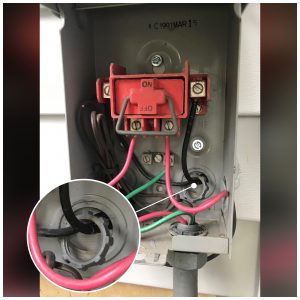How Separated Conduit Can Hurt You

After looking at thousands of houses and seeing many different ways to connect electric, I am still amazed that people who don’t know what they are doing are making an attempt to install electric. Here in Chicagoland, we are one of three main metropolitan areas that require residential electric to be in conduit. Most of the United States will accept non-metallic cable (NMC). Most of us recognize NMC by one manufacturer’s name “Romex”. The argument between which is better has been fought for years by electrician and inspectors alike.
The Pros of Conduit
- If wires need to be removed, you can just pull out the old and put in the new.
- The conduit protects the wires from screws or nails driven into the studs.
The Pros of NMC
- It’s cheaper and easier to install.
- It has a ground wire already installed in the cable (sometimes)
For me, grounding and bonding are vitally important. In conduit systems, we use the conduit as the grounding conductor. There are a few reasons why we need a ground wire or grounding conductor in our branch circuits.
- To keep all items at the same potential as the earth (we will call that potential 0).
- Should an energized conductor become loose, there will be another pathway back to the neutral conductor to allow a massive amount of electricity to flow. This massive amount will be far more than what is required to trip the breaker. The goal is to turn off the power as fast as possible. The shorter the time things are energized, the less chance of someone to get hurt.
The photo above is a disconnect box for an air-conditioner. The zoomed in section shows the box is not connected to the conduit behind the box. The air-conditioner attached to this box was functioning normally. The problem happens when one of those two wires gets damaged and the conductors inside the wires are exposed and touch the box, piping, or the cabinet for the air-conditioner. Those live wires will energize the case. The case will remain energized because there is not enough electrical flow to cause the breaker to trip. The breaker will see this as normal. Even if a wire is connected to the air-conditioner and the other end is connected to the earth. No more than roughly 5 amps will flow into the earth. Since a 15-amp breaker is usually the smallest one we see inside an electrical panel, the 5 amps flow will seem normal to the breaker and it will continue to allow the electric to flow. Hence the exterior cabinet will remain energized. Now think about our children playing near the energized air-conditioner. Running in their bare feet. The earth is a little wet and they touch the cabinet of the air-conditioner. Electricity will flow through them. Again, since the earth is a big resistor, the electrical flow will be limited to about 5 amps. Not enough for the breakers inside the home to think there is a problem and turn the power off.
If we had that conduit connected. And, assuming that all the conduit is connected; as soon as the energized conductor touched the conduit, the electricity would flow back to the electrical panel. In that panel should be a bond. This bond connects the grounding system to the neutral system. The neutral system does not have any resistance on it, which will also massive amounts of electricity to flow. More than enough to trip the breaker and turn the power off. All this happens in a split second. That is the purpose of the conduit. That is the main reason we need to have the conduit connected.
Charlie Says, take a look around the house and if you see any of your conduit separated, please contact an electrician as soon as possible to get it fixed. A fully intact electrical system is needed to keep all the electrical wiring safe.

Charles Bellefontaine CMI, CPI, ACI
June 16, 2018
Uncategorized
No Comment